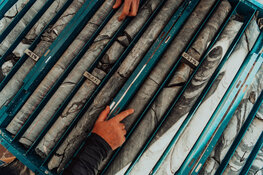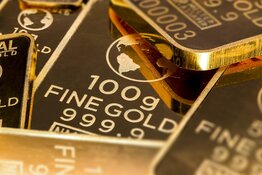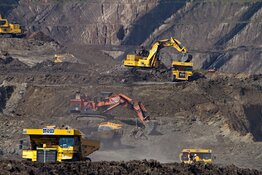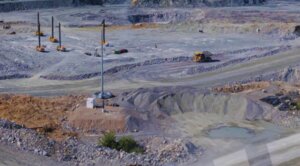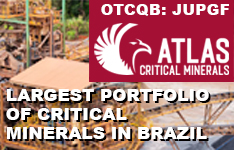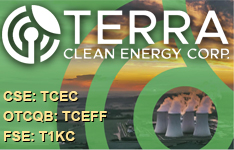Victor Gonçalves: This is basically the traditional summer lull, so I'm not overly concerned. In fact, I talked about this very thing in one of our previous interviews. There are certainly other factors involved. Typically when we have mid-term elections with a democratic president and what could be a republican house, this will be good for gold and the markets, but until that happens, the markets and the price of gold will be at a standstill.
TGR: In terms of investing in gold, do you advise your readers to have a certain percentage of gold bullion along with gold equities?
VG: In terms of bullion, I always say to have some, but the definition of "some" is a little ambiguous. I like gold, but I also like the moves that occur in the junior mining sector. One of the issues with gold bullion is the spread between the buy and sell side; the built-in "lose" in the spread between the buy and sell prices. That is to say, for those who want to trade gold, I don't recommend trading it frequently. For somebody who wants to buy it now, in the summer, I think they will strongly benefit as the price is probably at one of lowest points we will see going forward. So to answer the question, for conservative investors I recommend 10%–20%, and for aggressive traders, 0%, as they would have more opportunities with gold equities.
TGR: If an investor were building a gold portfolio today, would you recommend they start with a base of seniors, juniors and ETFs?
VG: Juniors and emerging producers hands down. This is probably the best piece of advice that anybody can take from this article. If there is one asset class that will outperform, it is the emerging producers. Basically, these companies trade with the multiple of a junior, which is basically none, but will more than likely have a producer's asset base and earnings in a reasonably short period of time. That, in my opinion, is a very sweet deal.
Having said that, however, I believe having one or two solid seniors is not a terrible thing. They will hold their value and perform according to the price of gold. Right now, with most equities prices being depressed, the best "bang for your buck" will be in the emerging mid-tier producers. There are some juniors that will be a great value eventually, but as a solid base, I don't recommend them as they carry much higher risk when compared to a company that has a mine, mill and production.
TGR: In terms of gold equities, I know you're partial to select juniors. What are the most important criteria to you? Management, project, jurisdiction, drill results or other factors?
VG: There are several factors, but I can never stress the most important one enough. . .management. Management is the root of all that is good for any company. Good management will know (or have a reasonably good idea) where to drill and get the good results. Good management will do the right deals to acquire the right projects; proper management will know which jurisdiction to be in, and if the jurisdiction is poor, then they will know how to mitigate the risks. All the good news we hope to see on the newswires stems from the management team's calculated decisions. This is why this is the quintessential element of a company; the rest will follow naturally.
TGR: What are a few of your favorite gold juniors going into the fall? Why?
VG: I have a few companies that I like right now. One of them is Century Mining Corporation (TSX.V:CMM). A month ago, Century Mining brought some low-profile scooptrams and jumbo drills from South Africa to its Lamaque Gold Mine in Val d'Or, Quebec. No other North American mining company has used this type of equipment before. These vehicles are only five feet high. Even I tower over them. The small size of these machines allows them to operate in smaller spaces, thus moving less dirt and waste, which means getting a higher grade out of the mine.
When underground, I watched this new equipment in action. Talk about productivity. The company is training their team on how to use this new equipment to increase productivity. They are now focused on adjusting blasting patterns and loading of the holes, to ensure minimal over-breakage on the blasted round. They have started to see positive results over the last month, and higher grades are coming out of the mine and into the mill. This type of operation requires time, as more stopes are opened, and room and pillar flats production increases.
I understand they have a couple more low-profile pieces of equipment on order. This seems like a logical purchase decision from what I have seen. This addition of modern technology, combined with rethinking the operation, should increase efficiencies by a very nice factor. Of the three zones to be mined and operated in 2010, the room and pillar flats are just the beginning and will provide the lowest production of the three zones. Next in line is the Bedard Dyke Gold Zone, which was opened up the same day I arrived at the mine site, and finally, they are moving on to the North Wall zone.
The Bedard Dyke will be a very welcome addition to the mill, as it will be a long-hole, open-stope complex, and is expected to grade higher than the flats. The face of the Bedard Dyke portal, prior to its first blast, graded 37 grams per ton gold (g/t Au), and recent drilling showed intersections close to 100 g/t Au. The daily tonnage expected from the Bedard Dyke will be significantly higher than the flats, as it is the meat and gravy of the operation's future. The Goldex Mine (Agnico-Eagle Mines Ltd. (NYSE:AEM; TSX:AEM), down the road a few kilometers, is mining below 5,500 feet with a head grade of only 2.8 g/t Au, but is moving a lot of ore via their long-hole stopes, and at a low mining cost. I can see the Bedard Dyke lowering their operating costs at Lamaque going forward.
An interesting point is that the development work required to access the Bedard Dyke will be right through this high-grade vein before they access the underground to extract their 20,000 ton bulk sample. Obviously, this material will be crushed and sent to the mill, as it has plenty of visible gold, as well as massive chalcopyrite widely disseminated all through the veins. Once the sample is removed and tested, the company will look to receiving its next permit to mine the zone.
In terms of the current mill operation, it is operational and processing about 700 tons per day (tpd), with tonnage from underground reaching peaks of 700 to 750 tpd. The mill can be cranked up to adjust for higher tonnage on any given day, as they have put through 1,100 tpd on certain days during the ramp-up of the facility. As in any normal startup and commissioning of an operation, this number is progressively increasing and will do so until they hit their daily tonnage requirements. A good thing is their 2010 requirement is only needed to average 1,200 tpd, and in 2011 just over 2,000 tpd. With a facility that can process 3,000–3,400 tpd, they have lots of extra capacity to ensure they don't operate too close and max out.
NioGold Mining Corp. (TSX.V:NOX; OTC:NOXGF.pk) is another company that I'm currently following. This company has been around for several years and has enjoyed a large degree of success in the field. The most recent of these successes was the release of their NI 43-101, which showed a total of 959,000 ounces of gold in the indicated, as well as the inferred categories on their Marban Block and Norlartic-Kierens deposits, located in the Malartic gold camp, Abitibi region, Quebec. This is just about the 1 million mark, but Chairman Mike Iverson and President Rock Lefrancois have something much bigger in mind.
To date, the company has put down over 45,000 meters of drilling and extensive historic data compilation to determine this. There is some major upside in the spots where the company has widely spaced drill holes. Based on the information they have so far, the million ounces are reasonably homogeneous and consistent in the ground. There are many holes that were drilled where the spacing between them was wider than permitted to be included in the 43-101 and thus could not be included. In discussions with the company, it is clear that they are looking for something much bigger at Marban Block and Norlartic-Kierens.
One thing is clear though, and that is that what is at Marban Block is now known, and though they are confident that there are more ounces to be found there, they are also looking to make that next big discovery. Based on their land holdings, their expertise and the planned 100,000-meter drill program the company has, I would be very surprised if the company does not make a significant new discovery in the near term.
NioGold has a very good and competent team in the field. An examination of the field maps shows that there is significant potential all over the NioGold property package. They also have a very good and competent corporate team. Simon Ridgway recently joined the advisory board of the company, which is very significant, as Ridgway is known for making very good strategic deals. This addition, to me, sounds the bell that the company is looking to add significant shareholder value. For NioGold, they are building shareholder value by entering into an option and joint venture agreement (July 6th, 2010) with Aurizon Mines Ltd. (TSX:ARZ; NYSE.A:AZK) in the Marban Block property, which I feel is a sweetheart deal. For a 50% interest in Marban Block, Aurizon must incur expenditures of C$20 million over three years, with a firm commitment to spend C$5 million within the first year. Aurizon must also complete an updated NI 43-101 resource estimate and make a resource payment equal to the sum of C$30 per ounce (or C$40 if the price of gold is above US$1,560 per ounce) at the time of payment. This would be on half the resource, as the option is for half the resource. Aurizon can earn an extra 10% by delivering a feasibility study. They can earn in an additional 5%, for a total of 65%, by arranging project financing for capital expenditures to place the project into commercial production.
NioGold will be the operator until Aurizon has earned their 50%, and after that it will be Aurizon. WOW! This has given the company C$20 million dilution-free dollars, plus a payment of C$30 or $40 dollars per ounce that NioGold retains. This has significantly added value to the company.
And finally, there's Fire River Gold Corp. (TSX.V:FAU; OTCQX:FVGCF; FSE:FWR). They recently announced assay results for their Nixon Fork Gold Mine in Alaska, which I visited last September.
Over the past couple of months, the company has been announcing some truly bonanza-sized intersections, from its ongoing re-evaluation program. During 2007–2008, the previous operator completed 9,400 meters from mostly underground drill stations in 110 holes. The results for these holes were never reported by the operator and have never been included in a resource assessment. Some examples of this are 27 g/t gold over 24 meters, 67 g/t over 3 meters, and 498 g/t over 3 meters. These results are amazing, and it is continuing to show the economic potential of the Nixon Fork mine. Some other highlights are that the company has been working on its Preliminary Economic Assessment for their tailings and has been receiving positive results as it is being worked through.
Also, as they announced recently, the cleanup of their mill facility, instead of being a liability to them and costing money, actually netted them just over $1 million. This further speaks to the project's vast potential to be economically viable.
Based on the already established infrastructure that was purchased with Nixon Fork, this project is looking like it is on a fast track to success.
The company has done a series of financings and after all that, it will have raised about C$10 million and is, therefore, well-financed. The other thing that was done on a corporate level that I don't normally talk about but I think is noteworthy was the issuing of options. This was done after announcing good news and not before, as many companies do. This speaks to the integrity of the company as well as to the faith that the project has value above the levels it has gone to on the back of the recent good news. I also want to note that since the last write-up, the company has successfully moved up to the Venture Exchange from the CDNX exchange.
At the mid-60 cent level, the company is looking attractive based on the value it has added to the project.
TGR: Victor, thanks for your latest insights. Much appreciated.
A proud and avowed Keynesian, Victor Gonçalves developed a strong background in economics at the University of Winnipeg, where he served as a Professor's Assistant as well as earning his degree. His Equities and Economics Report has been accurately picking winners and calling market direction. In 2007, for instance, he correctly predicted the Dow Jones topping 14,000 points and pegged uranium reaching $136 per pound and many more. In addition to EER, Victor also produces the Green Dollar Report as well as writes for a number of print and electronic publications including CIM Magazine (Canadian Institute of Mining), Western Standard, Barron's and Kitco. He also has been featured on BNN, Mining Industry TV and at numerous industry events and conferences.
Want to read more exclusive Gold Report interviews like this? Sign up for our free e-newsletter, and you'll learn when new articles have been published. To see a list of recent interviews with industry analysts and commentators, visit our Expert Insights page.
DISCLOSURE:
1) The following companies mentioned in the interview are sponsors of The Energy Report or The Gold Report: Aurizon Mines.
2) Victor Goncalves: I personally and/or my family own shares of all the mentioned in this interview. I personally and/or my family am paid by the following companies mentioned in this interview: None.


